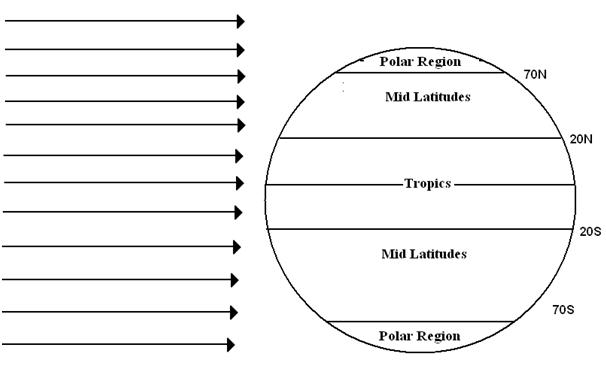About this page
The atmosphere is driven by heat from the sun. This is how it happens.
Related pages
Solar heating
The atmosphere is, in effect, a giant air conditioning system preventing the tropics from getting too hot and the poles too cold. The whole system is driven by heat from the sun but shaped by the fact that the earth is rotating and has a very non-uniform surface. The diagram shows radiation coming from the sun when it is right over the equator, at the equinox.
It can be seen that there is little variation in the amount of heat from the sun reaching the surface of the earth between the equator and, say, 20ºN or S. Similarly, in Polar Regions, there is no heat received at the pole itself and very little at 70ºN or S. In mid latitudes, there is a very marked change in the heating of the earth as latitude changes.

How the heat enters the atmosphere
The mechanisms
Heating of the earth by the sun is extremely non-uniform for a number of reasons. Clouds are very good reflectors as can be seen from an aircraft when it breaks through a cloud top. The sun shining off the cloud hurts the eyes (mine, at any rate). Snow and ice are also very good reflectors as is evidenced when lying snow remains even on bright sunny days. Over cloud, snow and ice, radiation from the sun is simply reflected back out to space with little effect.
The earth warms the air above it in three ways.
- Conduction - heating (or cooling) simply by contact of the air with the ground. This is very obvious at night over land when cooling of the ground can lead to fog or frost.
- Convection when air warmed by contact becomes less dense than surrounding air and, being buoyant, rises.
- Radiation of heat in the infra-red wavelengths with much of this heat escaping out to space but some being absorbed by gases in the air, mainly water vapour and carbon dioxide. This is known as the greenhouse effect and is the cause of the concern about global warming – see a later chapter on this topic.
Variations in the surface
The warming or cooling of the ground varies with time of day, time of year, latitude and nature of the surface. Oceans will heat up and cool down very slowly.
Deserts and other dry areas will heat up and cool down quickly. Conurbations, prairies forests and so on will all behave in different ways.
Slopes facing the sun will heat up quicker than those facing away from the sun. However, going from the sub tropics poleward, the overall result of the marked change in solar radiation reaching the surface of the earth in mid-latitudes is a significant decrease in the average temperature of the air between, say 35º and 65 ºN or S. This horizontal temperature gradient is the reason for the jet streams that circle the earth, albeit with some breaks. The mobile frontal lows and the high pressure systems that dominate mid-latitude weather form and move in association with the jet streams.
Latent heat
When air rises due to convection, orographic uplift or two air-streams converging, it cools. However, heat can be released through the latent heat effect. Conversely, when snow falls into air at temperatures higher than 0ºC it starts to melt. This needs heat which results in a cooling of the air. When rain falls through dry air, it will evaporate requiring latent heat. This cools the air and, in some cases, may cool the air so much that the rain turns to snow.
Latent heat has a far greater effects than might be thought. A single thunderstorm has energy around H-bomb levels. hurricanes are immensely more powerful still.
In a nutshell
- On average, the strongest variation of incoming heat is in mid-latitudes.
- There are marked diurnal and seasonal variations in the way the atmosphere is heated or cooled.
